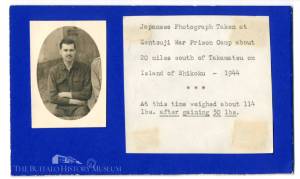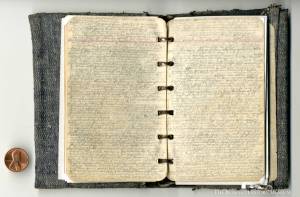French Toast – Dip stale slices in batter of thick milk (1/2 small cup/eggs),
sugar, salt, eggs, vanilla & fry with little more cream then pancakes – can deep fry
Does the recipe trigger a happy memory of cooking with a family member? Or a morning breakfast with a good friend? To Albert Chestnut a recipe was a motivator to help him survive. Albert was a prisoner of war. The Japanese held him captive in the Philippines and Japan for a total of three years and five months during World War II. While captive, he spent much of his time reading, playing cards and writing in his diaries about the poor and inadequate food he was served. At his lightest, Albert weighed less than 100 pounds, was malnourished and tried to obtain vitamins from Japanese doctors. Many of the final pages in Albert’s first diary are devoted to recipes and planning out weeks’ worth of meals for when he hopes to return home; return home to Buffalo.
For the past few months, I have been fortunate enough to spend time transcribing Albert’s diaries. Albert wrote in unusually tiny pencil handwriting, 1/16” at the most, which is why I have been devoting my time and eyes to transcribing his personal piece of history. Because of the pencil writing, there are often words or sections of pages that have become smudged or blurred making it difficult to read portions of the passages.
Albert Chesnut’s first diary begins around April 9th, 1942, the day the United States surrendered at Bataan and Americans and Filipinos were consequently taken captive by the Japanese. April 9th is also the first day of the Bataan Death March; a march that led Albert and the other prisoners up the Bataan peninsula stopping at Marveles, Cabatuan, St. Fernando and finally, ending at Camp O’Donnell, an eighty mile march, which was completed in only eleven days. After nearly seven months of being held at Camp O’Donnell, Albert’s hope of a quick rescue was beginning to fade; “November 1 – Must admit that am quite disappointed for honestly hope help would come by now.” Three days later Albert was sent by train back down to Manila, marched through the business district and held on a dock in the bay for four days. Over a thousand men were then packed below the deck of Nagato Maru, known as a Japanese Hell Ship, and sent to Japan. “November 7 – Last night a real terror – Left Manila about noon as part of big convoy – Really sort of glad to leave Philippines but even ocean breeze cannot help heat and stench of hold where have to eat too – Toilet facilities hopelessly inadequate – Two meals a day – Packed 75% of men below for night as heat terrific – Had hatch covered for time to keep out rain.”
Once in Japan, Albert was sent to Osaka and, on January 16, 1943, he began his stay at a camp know as Zentsuji. While there, Albert faced many of the same conditions as Camp O’Donnell; starvation, poor sanitary conditions, and a constant risk of life threatening diseases. Keeping his spirits up Albert spent much of his time reading censored Japanese newspapers, reading circulating books (“Franklin” by Bernard Fay, “The Well Tempered Listener” by Deems Taylor, “Hunchback of Notre Dame” by Victor Hugo), playing card games, attending prisoner run classes such as Spanish, Trigonometry and Bookkeeping, and going to lectures at night also given by other prisoners.
I am beginning transcription of the second diary and have reached December of 1944, but still have months to get through. As of December 1944, Albert is still being held at Zentsuji, but as I read, I routinely find heartbreaking entries such as these:
“March 17 1943 – Another glorious spring day for St. Patrick’s Day – Badly miss the little Irish box sis always sent for the season.”
“April 26 1943 – …Certainly miss Easter eggs and basket of other years which gave me so much pleasure for days afterwards.”
“June 6 1943– Today is sis’ birthday and feel sorry can’t help her celebrate.”
Reading and transcribing these diaries have taken me to another place in a different time and have reminded me to be grateful for everything I have. For curious readers, I skipped ahead to Albert’s final entry on October 22 1945; he writes “This was the day of days, the culmination of over four years of hoping, waiting and praying – At just past 12:30AM train left Buffalo and mother and sis waiting with box of cookies and other stuff.”
Albert Chestnut donated his diaries, the photograph in this post, his Army commission and other family papers in 1999 (Mss. A99-10). Due to the fragility of the diary bindings and the possible handling smudges, the physical use of the diaries are restricted to serious researchers with a valid ID from an institution of higher learning and are engaged in a PhD dissertation. I invite you to come in to the Research Library, take advantage of the transcription and take a transformational journey with Albert Chestnut.
Amy Miller
Assistant Librarian

